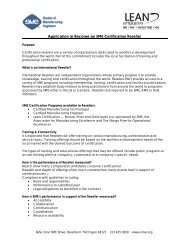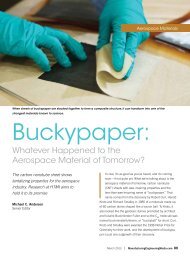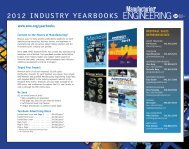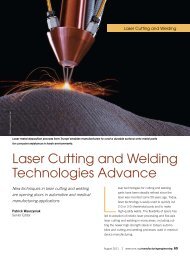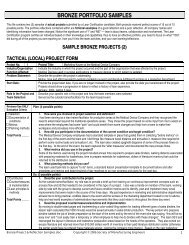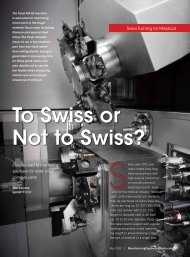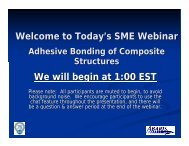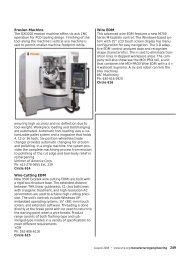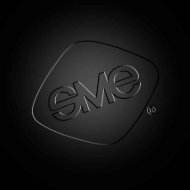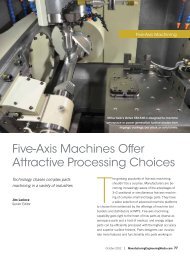The RAPID 2013 Conference & Exposition Directory - Society of ...
The RAPID 2013 Conference & Exposition Directory - Society of ...
The RAPID 2013 Conference & Exposition Directory - Society of ...
Create successful ePaper yourself
Turn your PDF publications into a flip-book with our unique Google optimized e-Paper software.
and heat source position-based element activation methods are<br />
evaluated, providing baseline data for the eventual validation <strong>of</strong><br />
these models to predict distortion and residual stress during laser<br />
cladding repair processes.<br />
3–3:25 pm<br />
Designing and Building Open Source Rapid<br />
Prototyping Machines<br />
Arif Sirinterlikci, PhD, Pr<strong>of</strong>essor <strong>of</strong> Engineering/Interim Head,<br />
Robert Morris University<br />
Robert Morris University (RMU) Manufacturing Engineering<br />
Laboratories are equipped with SLA, FDM, and ProMetal 3D<br />
printing systems. After working on biomodeling, rapid tooling and<br />
small metal parts fabrication projects, the RMU RP/AM Group is<br />
capturing one <strong>of</strong> the most recent and interesting developments<br />
in the area - open source and rep-rap systems. After building<br />
two fused filament machines and improving their accuracies, the<br />
group has recently completed another machine based on digital<br />
light processing (DLP) curing <strong>of</strong> polymers. This machine will be<br />
used in testing <strong>of</strong> different materials including composites. <strong>The</strong><br />
results will also lead to the development <strong>of</strong> a novel process and<br />
its associated hardware and s<strong>of</strong>tware. Details <strong>of</strong> the test results<br />
and machines will be a part <strong>of</strong> the presentation showing concrete<br />
evidence <strong>of</strong> the work.<br />
3:30–3:55 pm<br />
Additive Manufacturing’s Role in the Development<br />
<strong>of</strong> Safe, Compact, Integrated Fluid Power Systems<br />
Jonathon E. Slightam, Graduate Research Assistant, Rapid<br />
Prototyping Research, Milwaukee School <strong>of</strong> Engineering<br />
<strong>The</strong> Milwaukee School <strong>of</strong> Engineering (MSOE) is presently<br />
involved in the collaborative effort on the NSF funded Engineering<br />
Research Center for Compact and Efficient Fluid Power<br />
(ERCCEFP) Project 2G with Vanderbilt University and Georgia<br />
Tech. Project 2G: Fluid Power Surgery and Rehabilitation Via<br />
Compact Integrated Systems is aimed at breaking major technical<br />
barriers related to compact integrated systems (by designing<br />
systems where valves, cylinders, and sensors are not separate<br />
entities and can be manufactured simultaneously) and making<br />
fluid power systems safe and easy to use. Fully exploiting fluid<br />
power as a compact, efficient, and effective source <strong>of</strong> energy<br />
transmission is a vision <strong>of</strong> the ERCCEFP and MSOE seeks to<br />
exploit this vision with additive manufacturing. MSOE has sought<br />
to accomplish this by improving the understanding <strong>of</strong> additive<br />
technologies for applications in fluid power to develop more<br />
compact and inherently safe devices. Through MSOE’s efforts,<br />
novel actuators, mechanisms, non-assembly fluid power robots<br />
were developed. Modeling <strong>of</strong> additively manufactured fluidic<br />
bellows and comparison to other actuation technologies was<br />
a product <strong>of</strong> MSOE’s research to illustrate the feasibility <strong>of</strong><br />
additive manufacturing in fluid power robotic surgery. Prior work,<br />
collaborative efforts, future research and potential applications <strong>of</strong><br />
MSOE’s efforts are discussed.<br />
4–4:25 pm<br />
Laser Additive Manufacturing<br />
for Blow Mold Applications<br />
Lijue Xue, PhD, Senior Research Officer,<br />
National Research Council Canada<br />
Tony Paget, CEO, Garrtech Inc.<br />
Blow molding is a manufacturing process by which hollow plastic<br />
bottles or parts are produced. Aluminum alloys are typically used<br />
to make blow molds because <strong>of</strong> their good machining ability and<br />
thermal conductivity. However, aluminum alloys have relatively<br />
inferior wear resistance. During the blow molding operation,<br />
the parting lines or pinch-<strong>of</strong>f areas <strong>of</strong> the aluminum molds are<br />
subjected to severe wear as a result <strong>of</strong> compression and cyclic<br />
impact. In order to extend mold life, inserts made <strong>of</strong> hard and<br />
tough metals (typically, beryllium-copper) are usually used at<br />
the pinch-<strong>of</strong>f and other heavy wear areas, which significantly<br />
increases manufacturing cost and time. This presentation will<br />
report our development work on laser cladding <strong>of</strong> wear resistant<br />
materials to replace toxic beryllium-copper inserts, including<br />
property evaluation and durability study. Preliminary blow-mold<br />
production testing has demonstrated that laser-clad pinch-<strong>of</strong>f<br />
shows much longer life than the typical beryllium-copper insert,<br />
while it also provides additional benefits such as improved<br />
productivity and cosmetic improvement <strong>of</strong> the produced bottles.<br />
6/<strong>2013</strong> – <strong>RAPID</strong> 43





